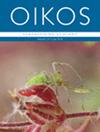Plant–mycorrhizal associations may explain the latitudinal gradient of plant community assembly
IF 3.1
2区 环境科学与生态学
Q2 ECOLOGY
引用次数: 0
Abstract
Biogeographical variation in community assembly processes forms the basis of the latitudinal gradient of biodiversity by driving β‐diversity. Classical studies on community assembly predict environmental filtering affecting β‐diversity more strongly at higher latitudes, where productivity is lower and abiotic stress is stronger. Contrary to this prediction, recent evidence indicates that plant community composition at higher latitudes exhibits more spatially clustered distributions independently of background environments, suggesting the importance of spatial processes, such as priority effects. In this study, we propose a hypothesis that resolves this paradox by considering plant–soil feedback and biogeographic variations in the dominant mycorrhizal type: we predict that the increasing prevalence of ectomycorrhizal (EcM) trees with latitude contributes to the spatially clustered distribution of plants, as EcM trees tend to exhibit positive plant–soil feedback. We analyzed a large‐scale standardized dataset of Japanese forests covering a latitudinal gradient of >10° and found that 1) the proportion of EcM trees was higher at higher latitudes, and 2) EcM tree‐rich communities exhibited more spatially clustered distributions likely due to positive plant–soil feedback. Consequently, 3) tree species composition at higher latitudes was better explained by spatial variables suggesting the importance of priority effects. Consistent with the predictions of the plant–soil feedback theory, these patterns were more pronounced in understory than in canopy communities. Taken together, our results lend support to our hypothesis that biogeographic variation in tree community assembly patterns is defined by mycorrhizal types and plant–soil feedback, thereby resolving a paradox in the latitudinal gradient of plant community assembly. Our work highlights that plant mycorrhizal type underlies the determinants of β‐diversity which is a critical component of the latitudinal gradient of diversity.植物与菌根的联系可以解释植物群落组合的纬度梯度
群落组合过程中的生物地理差异是生物多样性纬度梯度的基础,它驱动着β-多样性。关于群落组合的经典研究预测,在生产力较低、非生物压力较强的高纬度地区,环境过滤对 β 多样性的影响更大。与这一预测相反,最近的证据表明,高纬度地区的植物群落组成与背景环境无关,表现出更多的空间集群分布,这表明空间过程(如优先效应)的重要性。在本研究中,我们提出了一个假说,通过考虑植物-土壤反馈和优势菌根类型的生物地理学变化来解决这一矛盾:我们预测,随着纬度的增加,外生菌根(EcM)树木的普遍性会促进植物的空间集群分布,因为EcM树木倾向于表现出植物-土壤的正反馈。我们分析了纬度梯度为 10°的日本森林的大规模标准化数据集,发现:1)纬度越高,EcM 树的比例越高;2)富含 EcM 树的群落表现出更多的空间集群分布,这可能是由于植物-土壤的正反馈作用。因此,3)空间变量能更好地解释高纬度地区的树种组成,表明优先效应的重要性。与植物-土壤反馈理论的预测一致,这些模式在林下群落中比在林冠群落中更为明显。综上所述,我们的研究结果支持了我们的假设,即树木群落组合模式的生物地理差异是由菌根类型和植物-土壤反馈决定的,从而解决了植物群落组合纬度梯度的一个悖论。我们的研究突出表明,植物菌根类型是决定β多样性的关键因素,而β多样性是多样性纬度梯度的重要组成部分。
本文章由计算机程序翻译,如有差异,请以英文原文为准。
求助全文
约1分钟内获得全文
求助全文
来源期刊

Oikos
环境科学-生态学
CiteScore
6.20
自引率
5.90%
发文量
152
审稿时长
6-12 weeks
期刊介绍:
Oikos publishes original and innovative research on all aspects of ecology, defined as organism-environment interactions at various spatiotemporal scales, so including macroecology and evolutionary ecology. Emphasis is on theoretical and empirical work aimed at generalization and synthesis across taxa, systems and ecological disciplines. Papers can contribute to new developments in ecology by reporting novel theory or critical empirical results, and "synthesis" can include developing new theory, tests of general hypotheses, or bringing together established or emerging areas of ecology. Confirming or extending the established literature, by for example showing results that are novel for a new taxon, or purely applied research, is given low priority.
 求助内容:
求助内容: 应助结果提醒方式:
应助结果提醒方式:


